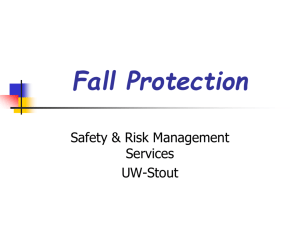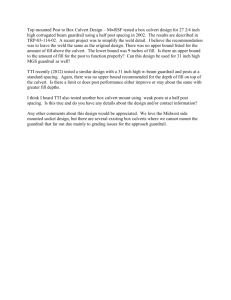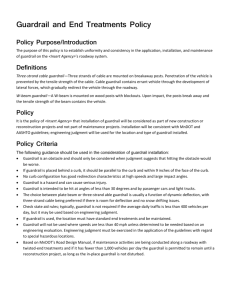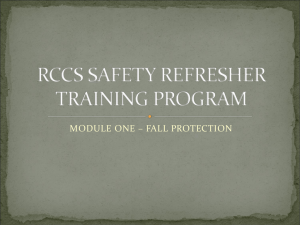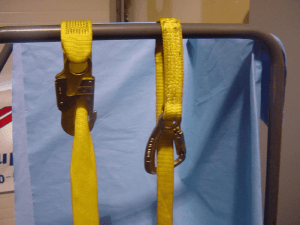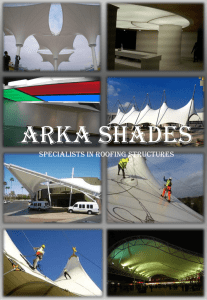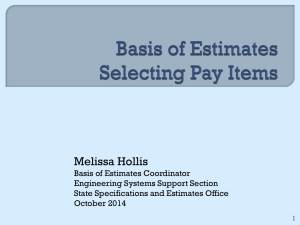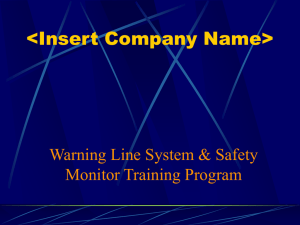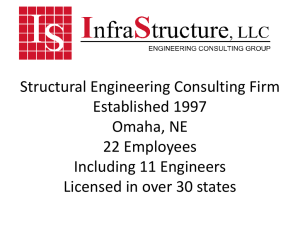Fall Protection for Construction
advertisement
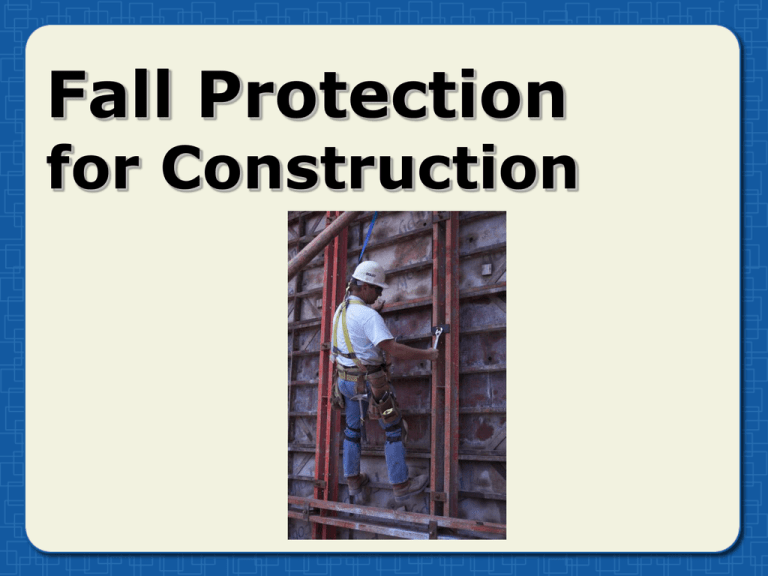
Fall Protection for Construction Fall hazards in the work area • Leading edge work • Overhand bricklaying • Holes, openings • Ramps, runways 2a Standard applicability • OSHA requires employers to: • identify, evaluate fall hazards • provide fall protection • train employees • Fall protection in other OSHA rules • scaffolding • ladders and stairways • steel erection 3a Fall protection measures • Surfaces must support employees • Provide protection: • at 6 feet and above • any fall into dangerous equipment • any falling objects 4a Fall protection measures • Guardrail systems • Safety net systems • Personal fall arrest systems (PFAS) • Positioning device systems 4b Fall protection measures • Warning line systems • Controlled access zones • Safety monitoring systems • Covers 4c Terms • • • • • Body belt Body harness Controlled access zone (CAZ) Guardrail system Personal fall arrest system (PFAS) • Positioning device system • Safety-monitoring system • Warning line system 5a Guardrail systems • Top rails 39 inches to 45 inches • Meet design/strength requirements 6a Safety net systems • Installed within 30 feet of working surface • Inspect: • at least once a week • after any incident 7a Personal fall arrest systems • Body belts are not part of a PFAS • Components meet design, strength requirements 8a Personal fall arrest systems • If using vertical lifelines, one employee per vertical lifeline • PFAS anchorages for PFAS only 8b Personal fall arrest systems • When stopping a fall: • limit force on employee to 1,800 pounds • no free fall over 6 feet • maximum deceleration distance of 3.5 feet 8c Positioning device systems • No free fall over 2 feet • Components meet design, strength requirements 9a Fall protection systems • Fall protection is needed: • • • • • unprotected sides and edges hoist areas holes wall openings formwork and reinforcing steel 10a Fall protection systems • Fall protection is needed: • ramps, runways, walkways • excavations greater than 6-feet deep • dangerous equipment • overhand bricklaying 10b Fall protection systems • Fall protection is needed: • • • • roofing work leading edge work precast concrete erection residential construction 10c Unprotected sides and edges • Fall protection options: • guardrail systems • safety net systems • PFAS 11a Protecting hoist areas • Fall protection options: • guardrail systems • PFAS 12a Protection for holes • Covers must: • support specified weights • be secured in place • be color coded or marked with a warning 13a Protecting wall openings • Fall protection options: • guardrail systems • safety net systems • PFAS 14a Formwork and reinforcing steel • Fall protection options: • PFAS • safety net system • positioning device system • Not required while moving on rebar assemblies 15a Ramps, runways, and walkways • Must have guardrails when employees could fall 6 feet or more 16a Excavations • Protect excavations 6 feet or more in depth and not readily seen by: • guardrail systems • fences • barricades 17a Falls into dangerous equipment • Protect workers from falling into/onto dangerous equipment at any height 18a Overhand bricklaying • Fall protection options: • guardrail systems • PFAS • safety net systems • controlled access zones 19a Overhand bricklaying • Only masonry and mortar can be stored within 4 feet of the working edge • Regularly remove debris 19b Roofing on low-slope roofs • Fall protection options: • guardrail systems • safety net systems • PFAS 20a Roofing on low-slope roofs - options • A combination of warning line and: • • • • guardrail systems safety net systems PFAS safety monitoring systems 20b Roofing on low-slope roofs - options • On roofs 50 feet or less in width, can use a safety monitoring system alone • When a safety monitoring system is used: • competent person as safety monitor • safety monitor has no other duties • mechanical equipment is not used 20c Roofing on low-slope roofs - options • When a safety monitoring system is used: • authorized employees only follow safety monitor warnings 20d Roofing on low-slope roofs - options • When warning line systems are used: • • • • erected around all sides at least 6 feet from roof edge warning lines form access path warning lines meet design/strength requirements 20e Roofing on low-slope roofs - options • Falling object protection: • materials, equipment stored more than 6 feet from roof edge unless there are guardrails • materials stored near a roof edge must be stable 20f Roofing on steep roofs • Fall protection options: • guardrail systems with toeboards • PFAS • safety net systems 21a Leading edge work • Leading edge work 6 feet and above: • guardrail systems • safety net systems • PFAS • Must use a fall protection plan if these can’t be used • Controlled access zone 22a Leading edge work • Control lines: • 6 to 25 feet from the edge • along the entire length of the edge • connected to a guardrail or wall • flagged, marked at least every 6 feet • meet design/ strength requirements 22b Precast concrete erection • Erecting precast concrete members 6 feet above a lower level: • guardrail systems • safety net systems • PFAS • Must use a fall protection plan if these can’t be used • Controlled access zone 23a Precast concrete erection • Control line: • 6 to 60 feet from the edge, or • half the length of the member being erected, whichever is less, from the leading edge • along the entire length of the edge • connect to a guardrail, wall • meet design/strength requirements • flagged, marked at least every 6 feet 23b Residential construction • Fall protection options: • guardrail systems • safety net systems • PFAS • Use a fall protection plan if these are infeasible 24a Fall protection plans • Can only use a fall protection plan with: • leading edge work • precast concrete erection work • residential construction work 25a Other walking/working surfaces • Fall protection options: • guardrail system • safety net system • PFAS 26a Protection from falling objects • Wear hard hats • Employers must also do one of the following: • erect toeboards, screens, guardrails • erect a canopy; keep objects far from the edge • barricade the area; keep workers out 27a

